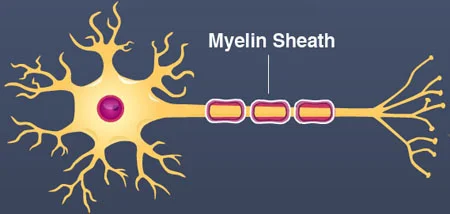Oligodendrocytes and Schwann cells are types of glia, the non-neuronal cells in the nervous system that carry out a wide variety of functions. Schwann cells are sometimes called neurilemma cells, since the outer layer of the myelin sheath is also called the neurilemma. Let's go through a list of the major similarities and differences between these two classes of glia.
Similarities between oligodendrocytes and Schwann cells
They both produce myelin
Both classes of glia are important for generation of myelin, a fatty substance made up of cell membranes that wraps around the axons of neurons. Myelin functions as an “insulator” of sorts. It prevents ion leakage down the axon, meaning that when an action potential is triggered in a myelinated axon, it gets sent along the axon much more quickly compared to an unmyelinated axon. For example, in a myelinated axon, an action potential can travel up to 100 m / s. Myelin is not continuous through the entire axon; instead, small patches of unmyelinated axon called Nodes of Ranvier are where the action potential can be detected.
They both provide trophic support for the neuron
Both of these glial cell types provide trophic support for the neuron along the axon. Some axons may be meters long, and it is important that nutrients are able to support the metabolic demands of the neuron. The oligodendrocytes and Schwann cells both secrete neurotrophic factors, which promote neuronal viability.
Differences between oligodendrocytes and Schwann cells
Oligodendrocyte myelination
Cell location
The location of these glial cells can be helpful in differentiating the cell types. For one, oligodendrocytes are only found in the central nervous system - the brain and spinal cord. On the other hand, Schwann cells are found in the peripheral nervous system. Schwann cells myelinate the nerve cells that project to and from our muscles, internal organs, and the other signals in the peripheral nervous system.
Number of axons myelinated
Oligodendrocytes are capable of myelinating multiple axons at once. The prefix oligo- refers to a few, as opposed to a single axon. The dendro- is from the word tree, because the cells themselves make several branches. Oligodendrocytes have a nucleus, and surrounding the nucleus is a series of cytoplasmic extensions which extend all the way to the axons. Schwann cells, however, are only responsible for myelinating a small section of an axon.
Developmental origin
As the nervous system develops, different cells types originate from different populations of cells. Oligodendrocytes are derived from oligodendrocyte precursor cells. Schwann cells, on the other hand, are derived from the neural crest.
Associated dysfunctions
Deficits in the oligodendrocytes can lead to a variety of diseases such as multiple sclerosis or cerebral palsy. On the other hand, some of the diseases associated with Schwann cell dysfunction include Guillain-Barre syndrome or Charcot-Marie-Tooth disease.

